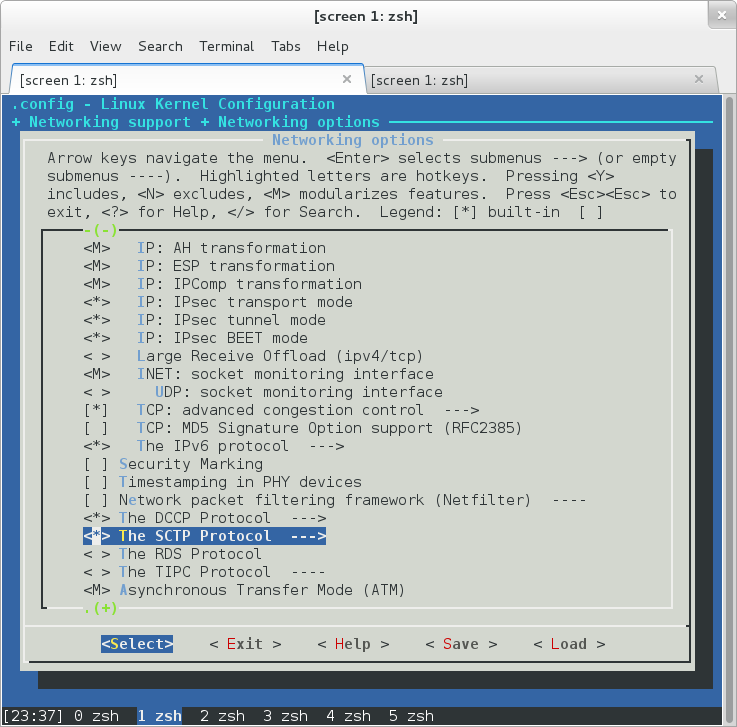Using your in-kernel protocol implementation¶
There are a number of protocols implemented in kernel space, like many transport protocols (e.g., TCP, UDP, SCTP), Layer-3 forwarding plane (IPv4, v6 with related protocols ARP, Neighbor Discovery, etc). DCE can simulate these protocols with ns-3 and a kernel compiled as a library. This is not possible with the linux vanilla kernel hence you need to use a slightly modified kernel (net-next-sim - deprecated - or libos which is the successor of net-next-sim).
This document describes how to retrieve, configure, compile and use this custom kernel in DCE. As an example, it shows how to enable an in-tree but optional protocol - Stream Control Transmission Protocol (SCTP) - and an out of tree protocol: Multipath TCP (MPTCP). Although other protocols may not adapt these patterns as-is, you will see what’s needed to implement for your purpose.
2. Build a DCE compatible linux kernel¶
DCE can simulate these protocols with ns-3 and a kernel compiled as a library named liblinux.so. This is not possible with the linux vanilla kernel hence you need to use a slightly modified kernel (net-next-sim - deprecated - or libos which is the successor of net-next-sim). The following section presents the two methods, net-next-sim being slightly easier to install.
2.1 With net-next-sim (deprecated)¶
To build the liblinux.so, DCE version of Linux kernel,
make defconfig ARCH=sim
make library ARCH=sim
You can use make menuconfig command (below) instead of editing the defconfig file. If everything is fine, you will see liblinux.so linked to libsim-linuxv.y.z.so file at the root directory of Linux kernel.
make menuconfig ARCH=sim
2.2 Build an MPTCP kernel with net-next-sim¶
DISCLAIMER: This is a transcript of Hajime’s guide https://plus.google.com/+HajimeTazaki/posts/1QUmR3n3vNA updated on a best effort basis. Hence it may be possible to compile newer versions, in which case patches are welcome. Build steps for DCE integration is also available as a script in utils/mptcp-build.sh.
Get linux kernel mptcp variant:
$ git clone mptcp_git_ $ git checkout -b sim3.14 mptcp_v0.89
Merge in mptcp code the changes required to make it work in DCE. Those changes are listed in the net-next-sim project
% cd mptcp % git remote add dce git://github.com/direct-code-execution/net-next-sim.git % git fetch dce % git merge dce/sim-ns3-3.14.0-branch
Enable mptcp in the kernel configuration. There are 2 ways possible:
patch the kernel config manually (you can
% cat >> arch/sim/defconfig <<END CONFIG_MPTCP=y CONFIG_MPTCP_PM_ADVANCED=y CONFIG_MPTCP_FULLMESH=y CONFIG_MPTCP_NDIFFPORTS=y CONFIG_DEFAULT_FULLMESH=y CONFIG_DEFAULT_MPTCP_PM="fullmesh" CONFIG_TCP_CONG_COUPLED=y CONFIG_TCP_CONG_OLIA=y END
- or use menuconfig to enable these options as explained in http://multipath-tcp.org/pmwiki.php/Users/DoItYourself
% make menuconfig ARCH=sim
Generate the kernel configuration:
% make defconfig ARCH=sim
build kernel (as a shared library)
$ make library ARCH=sim
If everything is going well, you can try to use it over ns-3
build ns-3 related tools
% make testbin -C arch/sim/test
run an mptcp simulation !
% cd arch/sim/test/buildtop/source/ns-3-dce % ./waf --run dce-iperf-mptcp
you should see generated *.pcap files in your dce folder.
2.3 With libos¶
Libos is the successor of net-next-sim. There are attempts to merge libos within the linux kernel library lkl project but it will take quite some time before being able to run lkl in DCE.
Get libos code:
$ git clone git@github.com:libos-nuse/net-next-nuse.git $ git checkout libos-v4.4 $ cd net-next-nuse
Configure the kernel (you can refer to configure)
make defconfig ARCH=lib
Compile the kernel
make library ARCH=lib
This will download and compile git submodules from https://github.com/libos-nuse/linux-libos-tools and execute additionnal steps from the arch/lib/tools/Makefile, as for instance generate an additional libsim_linux.so. This is the shared library you need to load in DCE. By default DCE looks for “liblinux.so” so you should do:
DceManagerHelper dceManager; dceManager.SetNetworkStack ("ns3::LinuxSocketFdFactory", "Library", StringValue ("libsim-linux.so"));
3. Write user space application to use this protocol¶
Then, we need to write userspace applications using new feature of kernel protocol. In case of SCTP, we wrote sctp-client.cc and sctp-server.cc.
Optional You may optinally need external libraries to build/run the applications. In this case, the applications need lksctp-tools, so that applications fully benefit the features of SCTP, rather than only using standard POSIX socket API.
Moreover, adding system dependency to bake configuration file (i.e., bakeconf.xml) would be nice to assist build procedure. The following is an example of lksctp-tools, which above applications use.
<module name="lksctp-dev">
<source type="system_dependency">
<attribute name="dependency_test" value="sctp.h"/>
<attribute name="try_to_install" value="True"/>
<attribute name="name_apt-get" value="lksctp-dev"/>
<attribute name="name_yum" value="lksctp-tools-devel"/>
<attribute name="more_information" value="Didn't find: lksctp-dev package; please install it."/>
</source>
<build type="none" objdir="no">
</build>
</module>
4. Write ns-3 scenario to use above applications.¶
The next step would be writing ns-3 simulation scenario to use the applications you prepared. You need first to add to your DCE_PATH the path to the previously compiled liblinux.so:
- ::
- $ export DCE_PATH=”$HOME/net-next-sim:$DCE_PATH”
dce-sctp-simple.cc is the script that we prepared. In the script, you may need to load the applications by using DceApplicationHelper as follows.
DceApplicationHelper process;
ApplicationContainer apps;
/* by default DCE, loads liblinux.so. If for some reason your library has a different name,
either create a symlink or use these commands to change the name */
DceManagerHelper dceManager;
dceManager.SetNetworkStack ("ns3::LinuxSocketFdFactory", "Library", StringValue ("liblinux.so"));
process.SetBinary ("sctp-server");
process.ResetArguments ();
process.SetStackSize (1<<16);
apps = process.Install (nodes.Get (0));
apps.Start (Seconds (1.0));
process.SetBinary ("sctp-client");
process.ResetArguments ();
process.ParseArguments ("10.0.0.1");
apps = process.Install (nodes.Get (1));
apps.Start (Seconds (1.5));
5. run it !¶
./waf --run dce-simple-sctp
If you’re lucky, it’s done.
If you aren’t lucky, you may face errors of DCE, such as unresolved symbols in system calls (called by userspace applications) or missing kernel functions (used by newly added CONFIG_IP_SCTP option), or invalid memory access causing segmentation fault. In that case, adding missing functions, so called glue-code would be the next step.
